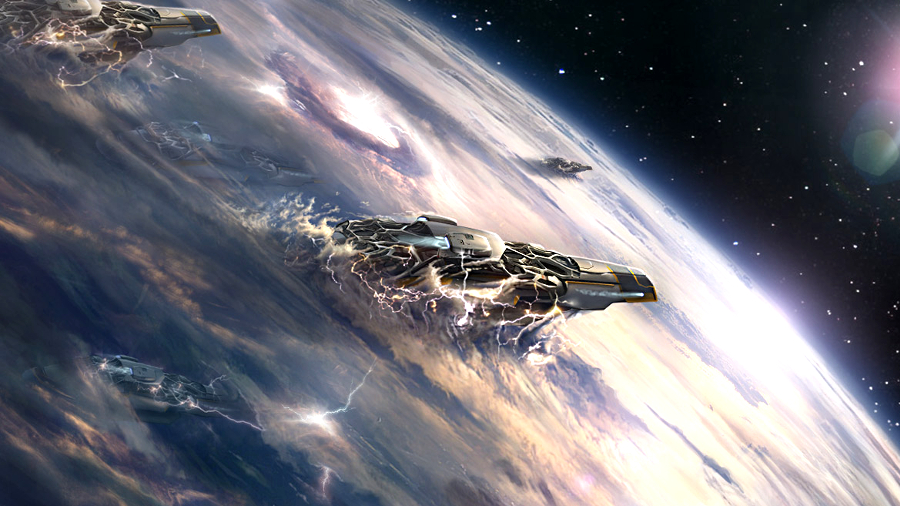
In this article, PC Format looks at building the ultimate triple-GPU dream machine. PC Format is the magazine for PC gamers and hardware enthusiasts, created by geeks and gamers. Each issue covers the latest advances in graphics cards, processors, motherboards, memory, SSDs and complete systems. We also feature guides on overclocking, tweaking, system building, system modding and PC repair. Click here to subscribe.
There is a certain theological argument that the entire point of mankind's existence and evolution is to become gods. Every step in our development as a species, from the emergence of life from the primordial soup, to the first time our fishy ancestors stood on terra firma, to a man in an ape suit throwing a KFC chicken drumstick at Stanley Kubrick, has been towards becoming deities. It makes sense: what better way to ensure our survival than to become omnipotent and immortal?
But there are gods are already moving among us. You won't find them in magic neverending sky palaces or the Great Pyramid of Giza. Instead they're more likely to be slurping coffee by the gallon in the swanky studios of a games company. These are the closest things we have to divine beings walking among us.
It's fairly obvious that these people are playing god by controlling and scripting the AI entities which inhabit a game's world. They shape the landscape, arrange the flora, set the weather and map routes. They build lands and breed their inhabitants; they control everything from the design of an abode's wallpaper to the shape of entire planets.

But this isn't anything new: artists and writers have been creating fictional places for millennia. There's another layer of activity happening here – one that's more profound and more philosophical. Game designers are actively engaging with and changing the way that gamers – people like you and me – think, act and react. They're telling us which path we should take, or who to kill and who to save, using sometimes incredibly subtle psychological cues to make us feel fear, or comfort, or anger. And they're putting in a huge amount of hard work to take us to utopias and dystopias.
Over the next four pages, we chat to some of the most important names in game development to tell the story of game design, and to get to grips with the intricate ideas, theories and perspectives that explain how interactive entertainment is built.
Game studies
Want to design games? Dayna Galloway explains Abertay University's various course options...
Get daily insight, inspiration and deals in your inbox
Sign up for breaking news, reviews, opinion, top tech deals, and more.
Game design is an enormous and broad subject that takes in many different academic disciplines: mathematics, physics, film and media studies, architecture, art and design, and sound engineering all play parts in the development of games. So how is it taught?
"At Abertay University we have the fortune to be able to teach game design within the broader context of games development, whereby our game design students have the opportunity to work alongside students studying for a degree in one of the other disciplines (programming, art, production and sound)," explains programme tutor Dayna Galloway.
"Our approach to teaching is a careful balance of theory and practice – we aim to ensure that our graduates can meet the demands of the industry today, but also that they possess the skills, confidence and knowledge to drive future innovation."
Abertay has made quite a name for itself as a go-to uni if you want to break into the games industry, and recent success stories include indie developer Pixel Blimp, which has become part of Microsoft Ventures' business mentoring program. Galloway describes the company's success as "a real testament to the quality of our degree programmes which encourage our students to apply their creative and technical skills in an entrepreneurial context."
Of course, not everyone will have the time and funds for a degree. Galloway recommends the following books for aspiring game designers: Rules of Play by Katie Salen and Eric Zimmerman, Game Design Workshop by Tracy Fullerton, and Game Feel by Steve Swink.
"All of these texts provide detailed critique and analysis of the game design process along with useful exercises to help you establish and develop a concept, as well as aiding with the practical aspects of prototyping and the development of a solid user experience," says Dayna.
Basic rules

In order to understand game design, we have to go back to the start of commercial gaming in the 1970s. However crude and unsophisticated they may appear now, games such as Pong, Pac-Man and Donkey Kong laid down rules of design that are still in play today; they're based on repetitive concepts that are simple to grasp, but can also be 'gamed' to the player's advantage.
"Pong is wonderful as it's such a simple concept and stands up to this day – the way that aggressive play can come back to haunt you leads to you playing a frantic game of risk and reward," explains Dayna Galloway, programme tutor for Abertay University's game design and production management degree. "Pac-Man is so iconic, and it's one of the first games that truly immersed me once I uncovered its systems and formed a strategy to increase the likelihood of success."
As the '70s drew to a close, systems were seeping out of enthusiasts' garages and university research labs, into people's homes and purpose-built arcades. Arcade games in particular had to be commercially viable. They had to look like they were easy to beat – to get your initials next to that high score – but they also had to turn a profit and drain teens' quarters.
On home systems, games could offer delayed gratification and a slower pace. According to Galloway, "Tetris deserves a mention as it has such a clear and rewarding loop of core gameplay – easy to pick up and difficult to truly master – and it also managed to achieve broad appeal across the spectrum of players. And Super Mario Bros is just a masterclass in good design."
The '80s became the '90s and new forms of gameplay emerged. 3D, which hit the mainstream with Doom and Wolfenstein, gave us multilayered levels to explore. The internet meant that people could play with or against each other. Core gameplay values and mechanics changed very little, though – a shooter is ostensibly just a platformer from a different perspective, and an MMO is much like playing Warhammer (albeit remotely rather than face-to-face).
But systems were perfected, control methods were honed, graphics were sharpened and gaming evolved. This decade also saw the beginnng of the series that Galloway believes has come to define good gameplay: Half-Life. "With the proliferation of narrative FPS games nowadays, we very much take for granted how innovative and truly ground-breaking this series was," he says.
Why are Valve's 1998 shooter and its 2004 sequel so highly regarded? "The use of environmental storytelling to make the player question and consider the events that have taken place," explains Galloway. "The implementation of intuitive, environmental puzzles that reward the player and provide a release of tension; the characterisation of Gordon Freeman within the confines of a silent protagonist; the rich, believable world that set the bar for art direction in games; and the artificial intelligence of the many foes that would aim to bring your adventure to a premature end."